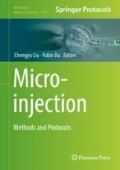Abstract
The primary cells isolated from the freshly dissected organ are thought to be different from those cultured for a long time in vitro. For instance, hepatocytes isolated in situ from the liver, display the ability to produce albumin, cultured for about a week often tend to cease production of albumin, including loss of proliferation capability. Thus, it is difficult to perform genome editing (i.e., production of genome-edited hepatocytes by in vitro gene delivery) in such cultured cells. Furthermore, hepatic cell lines available so far do not produce albumin and they would also have lost several characteristics of native liver cells. This poses a serious disadvantage when researchers want to study gene expression profiles under specific experimental settings, for example before and after genome editing. However, this demerit can be overcome if genome-editing is performed in situ in liver and single hepatocytes (both genome-edited and wild-type) can be isolated for analysis immediately following transient gene editing. Previously, we demonstrated successful isolation of genome-edited single hepatocytes, using mice expressing systemic Cas9 transgene (called “sCAT” mouse) and by tail-vein-mediated hydrodynamics-based gene delivery of gRNA targeted to Albumin gene (Sakurai et al., Sci Rep 6:20011, 2016). Here, we describe the detailed protocols for collection and analysis of single genome-edited hepatocytes, which will be useful for many types of hepatocyte functional studies.
Access this chapter
Tax calculation will be finalised at checkout
Purchases are for personal use only
References
Jinek M, Chylinski K, Fonfara I et al (2012) A programmable dual-RNA-guided DNA endonuclease in adaptive bacterial immunity. Science 337:816–821. https://doi.org/10.1126/science.1225829
Cong L, Ran FA, Cox D et al (2013) Multiplex genome engineering using CRISPR/Cas systems. Science 339:819–823. https://doi.org/10.1126/science.1231143
Mali P, Yang L, Esvelt KM et al (2013) RNA-guided human genome engineering via Cas9. Science 339:823–826. https://doi.org/10.1126/science.1232033
Platt RJ, Chen S, Zhou Y et al (2014) CRISPR-Cas9 knockin mice for genome editing and cancer modeling. Cell 159:440–455. https://doi.org/10.1016/j.cell.2014.09.014
Dow LE, Fisher J, O’Rourke KP et al (2015) Inducible in vivo genome editing with CRISPR-Cas9. Nat Biotechnol 33:390–394. https://doi.org/10.1038/nbt.3155
Sakurai T, Kamiyoshi A, Kawate H et al (2016) A non-inheritable maternal Cas9-based multiple-gene editing system in mice. Sci Rep 6:20011. https://doi.org/10.1038/srep20011
Carroll KJ, Makarewich CA, McAnally J et al (2016) A mouse model for adult cardiac-specific gene deletion with CRISPR/Cas9. Proc Natl Acad Sci U S A 113:338–343. https://doi.org/10.1073/pnas.1523918113
Chu VT, Graf R, Wirtz T et al (2016) Efficient CRISPR-mediated mutagenesis in primary immune cells using CrispRGold and a C57BL/6 Cas9 transgenic mouse line. Proc Natl Acad Sci U S A 113:12514–12519. https://doi.org/10.1073/pnas.1613884113
Nakao H, Harada T, Nakao K et al (2016) A possible aid in targeted insertion of large DNA elements by CRISPR/Cas in mouse zygotes. Genesis 54:65–77. https://doi.org/10.1002/dvg.22914
Zhang L, Zhou J, Han J et al (2016) Generation of an oocyte-specific Cas9 transgenic mouse for genome editing. PLoS One 11:e0154364. https://doi.org/10.1371/journal.pone.0154364
Cebrian-Serrano A, Zha S, Hanssen L et al (2017) Maternal supply of Cas9 to zygotes facilitates the efficient generation of site-specific mutant mouse models. PLoS One 12:e0169887. https://doi.org/10.1371/journal.pone.0169887
Nagy A, Marina Gertsenstein M, Kristina Vintersten K et al (eds) (2003) Manipulating the mouse embryo: a laboratory manual, 3rd edn. Cold Spring Harbor Laboratory Press, New York
Kawai S, Takagi Y, Kaneko S et al (2011) Effect of three types of mixed anesthetic agents alternate to ketamine in mice. Exp Anim 60:481–487
Liu F, Song Y, Liu D (1999) Hydrodynamics-based transfection in animals by systemic administration of plasmid DNA. Gene Ther 6:1258–1266. https://doi.org/10.1038/sj.gt.3300947
Kamiyoshi A, Sakurai T, Ichikawa-Shindo Y et al (2006) Endogenous alphaCGRP protects against concanavalin A-induced hepatitis in mice. Biochem Biophys Res Commun 343:152–158. https://doi.org/10.1016/j.bbrc.2006.02.132
Sakurai T, Watanabe S, Kamiyoshi A et al (2014) A single blastocyst assay optimized for detecting CRISPR/Cas9 system-induced indel mutations in mice. BMC Biotechnol 14:69. https://doi.org/10.1186/1472-6750-14-69
Acknowledgments
This study was supported by JSPS KAKENHI Grants (Nos. 26293085, 26670153 and 16K15233) from the Japanese Ministry of Education, Culture, Sports, Science, and Technology.
Author information
Authors and Affiliations
Corresponding author
Editor information
Editors and Affiliations
Rights and permissions
Copyright information
© 2019 Springer Science+Business Media, LLC, part of Springer Nature
About this protocol
Cite this protocol
Sakurai, T., Kamiyoshi, A., Ohtsuka, M., Gurumurthy, C.B., Sato, M., Shindo, T. (2019). Isolation and Analysis of a Genome-Edited Single-Hepatocyte from a Cas9 Transgenic Mouse Line. In: Liu, C., Du, Y. (eds) Microinjection. Methods in Molecular Biology, vol 1874. Humana Press, New York, NY. https://doi.org/10.1007/978-1-4939-8831-0_15
Download citation
DOI: https://doi.org/10.1007/978-1-4939-8831-0_15
Published:
Publisher Name: Humana Press, New York, NY
Print ISBN: 978-1-4939-8830-3
Online ISBN: 978-1-4939-8831-0
eBook Packages: Springer Protocols

